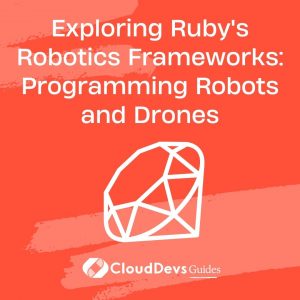Exploring Ruby’s Robotics Frameworks: Programming Robots and Drones
In an era driven by technological innovation, the realm of robotics and drones has seen remarkable growth. These autonomous machines have found applications in various industries, from manufacturing and agriculture to healthcare and entertainment. If you’re eager to embark on an exciting journey into the world of robotics and drones, Ruby, the versatile programming language, has some fantastic frameworks and libraries waiting for you.
Table of Contents
In this comprehensive guide, we will delve into the captivating universe of Ruby’s robotics frameworks. You’ll discover how to program robots and drones, control their movements, and leverage the power of Ruby to create innovative robotic applications.
1. Understanding Ruby’s Role in Robotics
Before we dive into the robotics frameworks, let’s briefly explore why Ruby is a compelling choice for robotics development. Ruby is known for its simplicity and readability, making it an ideal language for prototyping and developing robotics projects. Its dynamic nature and robust ecosystem of gems (libraries) provide developers with a powerful toolkit.
Additionally, Ruby’s community is known for its supportive nature, making it easier for enthusiasts and professionals to collaborate, share knowledge, and solve problems. With these advantages in mind, let’s explore some of the top robotics frameworks available for Ruby.
2. ROS (Robot Operating System)
2.1. Introduction to ROS
The Robot Operating System (ROS) is a widely adopted framework in the robotics world. While it is primarily associated with C++ and Python, there are Ruby bindings available, making it accessible to Ruby enthusiasts.
ROS provides a middleware framework for developing software for robots and drones. It offers a plethora of tools and libraries that simplify tasks like hardware abstraction, device drivers, communication between processes, and visualization.
2.2. Ruby ROS Libraries
To work with ROS in Ruby, you’ll need to utilize the ‘ros-ruby’ gem. This gem provides Ruby bindings for ROS, allowing you to interface with ROS nodes and interact with robot hardware seamlessly. Here’s a simple code snippet to demonstrate how to create a ROS node in Ruby:
ruby
require 'ros'
Ros::init(['my_robot_node'], [])
node = Ros::Node.new('/my_robot_node')
while node.ok?
# Your robot control logic goes here
end
This code initializes a ROS node named ‘my_robot_node’ and enters a loop for robot control logic.
2.3. Why Choose ROS for Ruby Robotics?
ROS is a powerful choice for Ruby developers due to its extensive community support and well-documented resources. You can leverage the vast collection of pre-existing ROS packages and contribute to the robotics community by creating Ruby-based ROS packages.
3. Artoo
3.1. Introduction to Artoo
Artoo is a delightful robotics framework designed explicitly for Ruby. It simplifies the process of building and controlling robots and drones. With Artoo, you can program a wide range of robotic platforms, including Arduinos, Raspberry Pis, and drones like the Parrot AR.Drone.
One of Artoo’s standout features is its versatility in working with various hardware platforms. Whether you’re building a land-based robot or a flying drone, Artoo has you covered.
3.2. Getting Started with Artoo
To begin using Artoo, you’ll need to install the ‘artoo’ gem:
bash gem install artoo
Once installed, you can start building your robotic application. Here’s a simple example of using Artoo to control a robot’s movement:
ruby require 'artoo' connection :sphero, adaptor: :sphero, port: '/dev/tty.Sphero-RGY-AMP-SPP' device :sphero, driver: :sphero work do sphero.set_color(:green) sphero.roll(60, 0) sleep 2 sphero.stop end
In this code, we connect to a Sphero robotic ball, set its color to green, make it roll forward at a speed of 60, wait for 2 seconds, and then stop it.
3.3. Why Choose Artoo for Ruby Robotics?
Artoo is a fantastic choice for Ruby enthusiasts who want to explore robotics and drone programming. Its simplicity and compatibility with various hardware platforms make it an excellent starting point for robotics projects.
4. Gazebo
4.1. Introduction to Gazebo
Gazebo is a robust simulation environment widely used in robotics research and development. While it is primarily associated with C++ and Python, you can harness its power with Ruby through the ‘gazebo’ gem.
With Gazebo, you can create highly realistic simulations of robots and drones, allowing you to test your code and algorithms in a virtual environment before deploying them to physical hardware. This helps save time, resources, and avoids potential mishaps during the development process.
4.2. Ruby Integration with Gazebo
To get started with Gazebo in Ruby, you’ll need to install the ‘gazebo’ gem:
bash gem install gazebo
Gazebo uses a physics engine to simulate the movements of robots and drones accurately. Here’s a simple code snippet that demonstrates how to create a simulated world and add a robot to it:
ruby
require 'gazebo'
world = Gazebo::World.new
robot = Gazebo::Model.new('my_robot', 'robot_description')
world.insert_model(robot)
world.start
This code creates a Gazebo world, adds a robot named ‘my_robot’ using a description provided in the ‘robot_description’ file, and starts the simulation.
4.3. Why Choose Gazebo for Ruby Robotics?
Gazebo’s simulation capabilities are invaluable for robotics developers. By integrating Ruby with Gazebo, you can test your robotic algorithms and control logic in a risk-free virtual environment, enhancing the reliability and safety of your robots and drones.
Conclusion
Embarking on a journey into the world of robotics and drones is an exciting endeavor. With Ruby’s powerful robotics frameworks like ROS, Artoo, and Gazebo, you have the tools you need to bring your robotic dreams to life. Whether you’re interested in hardware control, simulation, or drone programming, Ruby provides the flexibility and simplicity you seek.
As you explore these frameworks, remember that the world of robotics is ever-evolving, and there’s always more to learn. Embrace the challenges, experiment with different platforms, and contribute to the thriving Ruby robotics community.
So, are you ready to dive into the realm of robotics and drones with Ruby? Strap in, start coding, and watch your robotic creations come to life!
Table of Contents








